 |
Formation of Children
Catholic Funeral Etiquette - Part I
Marian T. Horvat, Ph.D.
Alongside the traditional religious feasts such as Christmas, Epiphany and Easter, there are the family feasts, which mark the principal events of the family life. The joyous days of Baptisms, First Communions, weddings and anniversaries are celebrated and commemorated by family members and close friends, giving each family its own small calendar of distinctive feasts that also have a religious character.
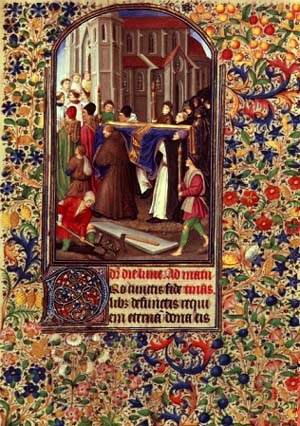
Funeral services from a Book of Hours |
Inescapably, sadness follows the joys; death is also a part of life.
As we grow older, we see the departure of our acquaintances, relatives and friends with whom we thought in our youth we could enjoy a life without end. However, night comes: nox atra venit.
As Catholics, we believe in the eternal life of the souls of our loved ones and nurture the hope of eternal salvation for Catholics who practice the Commandments and die in the state of grace; this consoles us when a family member or friend dies well. The good son or daughter will make arrangements so that his parents, family members and even close friends will be prepared for death by the visit of a Catholic priest.
At the hour of death, he is often with the dying person. He does not speak of family matters, bank accounts, or other such earthly affairs; rather, he suggests to the dying person pious thoughts, recites prayers and litanies, and offers him an image of the Crucified and the Virgin to kiss. After his last breath, he says a prayer for the repose of his soul, which now is facing the judgment of God. He asks Our Lady to be present at this crucial moment and mercifully intercede before the Eternal Judge.
Funeral customs
In the past, the funeral was held from the home or from funeral parlors. In the former case, rarely practiced in the United States today, the body was prepared to repose in the person’s own bed for twelve hours, during which time only family members were received to offer their last respects and prayers.
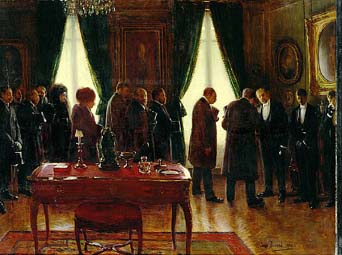
Friends come to offer condolences to relatives in their house parlor |
After this the coffin was placed in the living room, and the bereaved family received condolence visits from friends and neighbors. As a point of honor and respect, the family made sure that at least one person kept watch over the deceased at all hours until the body was taken to the Church for the requiem Mass and then burial. The term wake came from this time of watch.
In our country it has been the custom for some time to remove the body to a funeral home where it is embalmed and prepared for burial. This is supposedly a very sanitary custom, which allows the deceased person to be presented with make-up and a fine coiffure to look his or her very best at death. In fact, at American funerals it is common to hear such worldly remarks as “Oh my goodness! He looks so good, as least 20 years younger!” or “She never looked so pretty!”
This sterile and sanitized attitude toward death seems very superficial to me. The cosmetic presentation of the dead disguises the reality of death. It reflects the Protestant spirit, which does not want to be reminded of the sternness and seriousness of death and each one’s mortality. The grim, somber face of death is disguised or completely effaced; only smiles, compliments and glowing eulogies are permitted at the “services.” Gone are the serious rejoinders to contemplate death daily, to be prepared for it, and to pray for the repose of the soul of the deceased with the hope he merited eternal happiness.
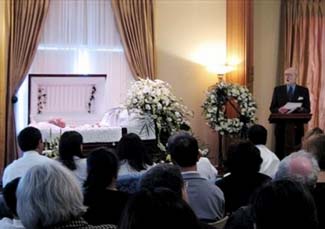
Eulogies and praise at a Protestant service at a funeral home |
In most Catholic countries of Europe and South America, it is not the custom to embalm. For example, in Portugal, Italy, Austria, Switzerland and Malta, as well as throughout South and Central America, embalming practices are not used. Only recently was the custom introduced in Spain and Germany.
The customs vary in each country, but in general, the deceased is laid out at the family home or the hospital chapel, often in an open coffin. During the visitation period, the body – natural in death – is viewed by family and friends. When possible, the requiem Mass is said “with the body present,” that is, with the deceased’s coffin, already covered, before it is taken to the cemetery.
Requiem Masses are also said on the 7th day and the 30th day after the death for the eternal rest of his soul. It is considered a social obligation to attend the 7th day Mass for those family members, friends, and business acquaintances who could not be present at the funeral. These Masses signify the last act of public mourning. The Mass said each year on the anniversary of the death of the loved one are usually attended only by family members and close friends.
Is not-embalming an option?
Allow me a short digression here on the topic of embalming.
Is it possible not to embalm a deceased love one in the United States? I had never considered the idea until recently when a good friend from Hungary, who lives here in California, buried her mother without the embalming process. The body was delivered to the funeral home and maintained under refrigeration until the burial three days later. At the Rosary, the casket was closed, but was opened for a short time when the family filed up to say farewell to her for the last time. The funeral director had suggested that the viewing of the open casket be reserved for family members, because he feared that seeing an un-embalmed body might disturb the sensibilities of Americans. Unwittingly, he made a telling commentary on the inability of Americans to face the reality of death.
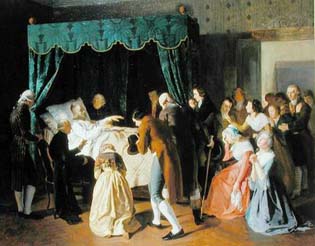
A man dies with a Catholic priest at his side and surrounded by praying family members |
After a little research, I learned federal law does not require embalming under any circumstances, and that a funeral home cannot require embalming unless it is State law. It is never required for the first 24 hours in any State. Some States require embalming after 24, 48, or 72 hours, but refrigeration is usually an option.
Continuing my inquiry into the embalming process, I was appalled at what it entails. After basic tests are performed on the corpse for signs of life, the limbs of the nude body are massaged to break the rigor-mortis, wires or adhesives are used to fix the jaw and “set the face,” machines suck out the internal fluids of the corpse and the fill the cavities with concentrated chemicals that contain formaldehyde, needles are poked here and there under the skin to inject more formaldehyde for a kind of Botox effect of beautification. All with the aim of destroying any vestige of suffering, old age and death. It seems to me an intrusive, artificial process that pays no mind to the Catholic teaching of the body as a temple of the Holy Ghost.
Therefore, if a Catholic family would like to consider the more traditional custom of burial without embalming for its loved ones, the matter is open. It is most probably possible. It is what I would like after my own death.
The odor of sanctity
Instead of the stench of death and rotting flesh, the bodies of various saints have emitted a lovable odor that is beyond compare to any known perfume. As a sign of sanctity, God at times permits the dead body to emanate a sweet perfume, a sign of the state of grace of the soul of the deceased. At other times, the pleasant aroma will be present in the room or building at the time of death and even for some time thereafter.
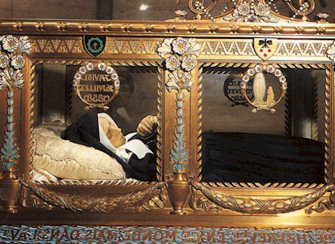
The incorrupt body of St. Bernadette in Lourdes
|
For example, a sweet perfume emanated throughout the convent the moment St. Teresa of Avila died. Also, the intense scent of roses could be smelled on the person of St. Therese of Lisieux at her death, a scent that lingered in the convent for days afterward. Neither of the Carmelite sisters were embalmed.
Among numerous such cases in the History of the Church, I mention the great Carmelite Doctor of the Church, St. John of the Cross. After a painful illness, he died at age 49. His body remained fresh and supple, emanating a fragrant perfume until his burial three days later. When his tomb was opened nine months after his death, the same pleasant smell rose from his incorrupt body. A layer of lime was applied to the body when it was reburied. Nonetheless, nine months later, the body of the Saint was found still perfectly preserved, as it remains to this date in the Church of Sts. John and Paul in Rome.
Continued

Posted June 25, 2008

Related Topics of Interest
 Requiescant in Pace... Requiescant in Pace...
 The Blessing - Manual of Civility The Blessing - Manual of Civility
 Something Fishy about the Death of John Paul II Something Fishy about the Death of John Paul II
 The Novissima - the Four Last Things The Novissima - the Four Last Things
 Americans Think Hell Exists, But No One Goes There Americans Think Hell Exists, But No One Goes There
 Importance of the Devotion to St. Joseph Importance of the Devotion to St. Joseph
 A Black-out on Black A Black-out on Black

Related Works of Interest
|
|
Formation | Cultural | Home | Books | CDs | Search | Contact Us | Donate

© 2002- Tradition in Action, Inc. All Rights Reserved
|
 |
|